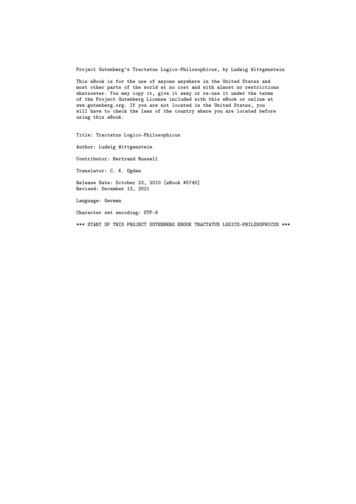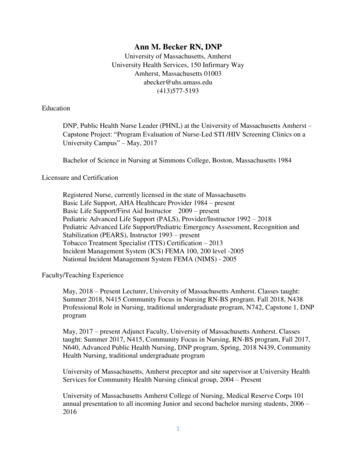
Transcription
Tractatus Logico-PhilosophicusLogisch-philosophische AbhandlungBy Ludwig WittgensteinFirst published by Kegan Paul (London), 1922.S IDE - BY- SIDE - BY- SIDE EDITION, VERSION 0.61 (M ARCH 21, 2022),containing the original German, alongside both the Ogden/Ramsey, and Pears/McGuinness English translations.Available at: http://people.umass.edu/klement/tlp/
IntroductionBy Bertrand Russell, F. R. S.M R . W ITTGENSTEIN ’ S Tractatus Logico-Philosophicus, whether ornot it prove to give the ultimate truth on the matters with which itdeals, certainly deserves, by its breadth and scope and profundity, tobe considered an important event in the philosophical world. Startingfrom the principles of Symbolism and the relations which are necessarybetween words and things in any language, it applies the result of thisinquiry to various departments of traditional philosophy, showing ineach case how traditional philosophy and traditional solutions ariseout of ignorance of the principles of Symbolism and out of misuse oflanguage.The logical structure of propositions and the nature of logical inference are first dealt with. Thence we pass successively to Theory ofKnowledge, Principles of Physics, Ethics, and finally the Mystical (dasMystische).In order to understand Mr. Wittgenstein’s book, it is necessaryto realize what is the problem with which he is concerned. In thepart of his theory which deals with Symbolism he is concerned withthe conditions which would have to be fulfilled by a logically perfectlanguage. There are various problems as regards language. First,there is the problem what actually occurs in our minds when we uselanguage with the intention of meaning something by it; this problembelongs to psychology. Secondly, there is the problem as to what isthe relation subsisting between thoughts, words, or sentences, andthat which they refer to or mean; this problem belongs to epistemology.Thirdly, there is the problem of using sentences so as to convey truthrather that falsehood; this belongs to the special sciences dealing withthe subject-matter of the sentences in question. Fourthly, there is thequestion: what relation must one fact (such as a sentence) have toanother in order to be capable of being a symbol for that other? Thislast is a logical question, and is the one with which Mr. Wittgensteinis concerned. He is concerned with the conditions for accurate Symbolism, i.e. for Symbolism in which a sentence “means” something quitedefinite. In practice, language is always more or less vague, so thatwhat we assert is never quite precise. Thus, logic has two problemsto deal with in regard to Symbolism: (1) the conditions for senserather than nonsense in combinations of symbols; (2) the conditionsfor uniqueness of meaning or reference in symbols or combinations ofsymbols. A logically perfect language has rules of syntax which preventnonsense, and has single symbols which always have a definite andunique meaning. Mr. Wittgenstein is concerned with the conditions fora logically perfect language—not that any language is logically perfect,or that we believe ourselves capable, here and now, of constructing alogically perfect language, but that the whole function of language isto have meaning, and it only fulfills this function in proportion as itapproaches to the ideal language which we postulate.The essential business of language is to assert or deny facts. Giventhe syntax of language, the meaning of a sentence is determined assoon as the meaning of the component words is known. In order that acertain sentence should assert a certain fact there must, however thelanguage may be constructed, be something in common between thestructure of the sentence and the structure of the fact. This is perhapsthe most fundamental thesis of Mr. Wittgenstein’s theory. That whichhas to be in common between the sentence and the fact cannot, hecontends, be itself in turn said in language. It can, in his phraseology,only be shown, not said, for whatever we may say will still need tohave the same structure.The first requisite of an ideal language would be that there shouldbe one name for every simple, and never the same name for two different simples. A name is a simple symbol in the sense that it has noparts which are themselves symbols. In a logically perfect languagenothing that is not simple will have a simple symbol. The symbol forthe whole will be a “complex”, containing the symbols for the parts. (Inspeaking of a “complex” we are, as will appear later, sinning againstthe rules of philosophical grammar, but this is unavoidable at theoutset. “Most propositions and questions that have been written aboutphilosophical matters are not false but senseless. We cannot, therefore,
answer questions of this kind at all, but only state their senselessness.Most questions and propositions of the philosophers result from thefact that we do not understand the logic of our language. They areof the same kind as the question whether the Good is more or lessidentical than the Beautiful” (4.003).) What is complex in the worldis a fact. Facts which are not compounded of other facts are what Mr.Wittgenstein calls Sachverhalte, whereas a fact which may consist oftwo or more facts is a Tatsache: thus, for example “Socrates is wise”is a Sachverhalt, as well as a Tatsache, whereas “Socrates is wise andPlato is his pupil” is a Tatsache but not a Sachverhalt.He compares linguistic expression to projection in geometry. Ageometrical figure may be projected in many ways: each of these wayscorresponds to a different language, but the projective properties ofthe original figure remain unchanged whichever of these ways maybe adopted. These projective properties correspond to that which inhis theory the proposition and the fact must have in common, if theproposition is to assert the fact.In certain elementary ways this is, of course, obvious. It is impossible, for example, to make a statement about two men (assuming for themoment that the men may be treated as simples), without employingtwo names, and if you are going to assert a relation between the twomen it will be necessary that the sentence in which you make theassertion shall establish a relation between the two names. If we say“Plato loves Socrates”, the word “loves” which occurs between the word“Plato” and the word “Socrates” establishes a certain relation betweenthese two words, and it is owing to this fact that our sentence is ableto assert a relation between the persons named by the words “Plato”and “Socrates”. “We must not say, the complex sign ‘aRb’ says that ‘astands in a certain relation R to b’; but we must say, that ‘a’ stands ina certain relation to ‘ b’ says that aRb” (3.1432).Mr. Wittgenstein begins his theory of Symbolism with the statement (2.1): “We make to ourselves pictures of facts.” A picture, he says,is a model of the reality, and to the objects in the reality correspond theelements of the picture: the picture itself is a fact. The fact that thingshave a certain relation to each other is represented by the fact that inthe picture its elements have a certain relation to one another. “In thepicture and the pictured there must be something identical in orderthat the one can be a picture of the other at all. What the picture musthave in common with reality in order to be able to represent it afterits manner—rightly or falsely—is its form of representation” (2.161,2.17).We speak of a logical picture of a reality when we wish to implyonly so much resemblance as is essential to its being a picture in anysense, that is to say, when we wish to imply no more than identityof logical form. The logical picture of a fact, he says, is a Gedanke.A picture can correspond or not correspond with the fact and be accordingly true or false, but in both cases it shares the logical formwith the fact. The sense in which he speaks of pictures is illustratedby his statement: “The gramophone record, the musical thought, thescore, the waves of sound, all stand to one another in that pictorialinternal relation which holds between language and the world. Toall of them the logical structure is common. (Like the two youths,their two horses and their lilies in the story. They are all in a certainsense one)” (4.014). The possibility of a proposition representing afact rests upon the fact that in it objects are represented by signs.The so-called logical “constants” are not represented by signs, but arethemselves present in the proposition as in the fact. The propositionand the fact must exhibit the same logical “manifold”, and this cannotbe itself represented since it has to be in common between the factand the picture. Mr. Wittgenstein maintains that everything properlyphilosophical belongs to what can only be shown, or to what is incommon between a fact and its logical picture. It results from this viewthat nothing correct can be said in philosophy. Every philosophicalproposition is bad grammar, and the best that we can hope to achieveby philosophical discussion is to lead people to see that philosophicaldiscussion is a mistake. “Philosophy is not one of the natural sciences.(The word ‘philosophy’ must mean something which stands above orbelow, but not beside the natural sciences.) The object of philosophyis the logical clarification of thoughts. Philosophy is not a theory butan activity. A philosophical work consists essentially of elucidations.The result of philosophy is not a number of ‘philosophical propositions’,but to make propositions clear. Philosophy should make clear anddelimit sharply the thoughts which otherwise are, as it were, opaqueand blurred” (4.111 and 4.112). In accordance with this principle the
things that have to be said in leading the reader to understand Mr.Wittgenstein’s theory are all of them things which that theory itselfcondemns as meaningless. With this proviso we will endeavour toconvey the picture of the world which seems to underlie his system.The world consists of facts: facts cannot strictly speaking be defined, but we can explain what we mean by saying that facts are whatmakes propositions true, or false. Facts may contain parts which arefacts or may contain no such parts; for example: “Socrates was a wiseAthenian”, consists of the two facts, “Socrates was wise”, and “Socrateswas an Athenian.” A fact which has no parts that are facts is called byMr. Wittgenstein a Sachverhalt. This is the same thing that he callsan atomic fact. An atomic fact, although it contains no parts that arefacts, nevertheless does contain parts. If we may regard “Socrates iswise” as an atomic fact we perceive that it contains the constituents“Socrates” and “wise”. If an atomic fact is analyzed as fully as possible(theoretical, not practical possibility is meant) the constituents finallyreached may be called “simples” or “objects”. It is a logical necessitydemanded by theory, like an electron. His ground for maintainingthat there must be simples is that every complex presupposes a fact.It is not necessarily assumed that the complexity of facts is finite;even if every fact consisted of an infinite number of atomic facts and ifevery atomic fact consisted of an infinite number of objects there wouldstill be objects and atomic facts (4.2211). The assertion that there isa certain complex reduces to the assertion that its constituents arerelated in a certain way, which is the assertion of a fact: thus if wegive a name to the complex the name only has meaning in virtue ofthe truth of a certain proposition, namely the proposition assertingthe relatedness of the constituents of the complex. Thus the namingof complexes presupposes propositions, while propositions presupposethe naming of simples. In this way the naming of simples is shown tobe what is logically first in logic.The world is fully described if all atomic facts are known, togetherwith the fact that these are all of them. The world is not describedby merely naming all the objects in it; it is necessary also to knowthe atomic facts of which these objects are constituents. Given thistotality of atomic facts, every true proposition, however complex, cantheoretically be inferred. A proposition (true or false) asserting anatomic fact is called an atomic proposition. All atomic propositions arelogically independent of each other. No atomic proposition implies anyother or is inconsistent with any other. Thus the whole business oflogical inference is concerned with propositions which are not atomic.Such propositions may be called molecular.Wittgenstein’s theory of molecular propositions turns upon histheory of the construction of truth-functions.A truth-function of a proposition p is a proposition containing pand such that its truth or falsehood depends only upon the truth orfalsehood of p, and similarly a truth-function of several propositionsp, q, r, . . . is one containing p, q, r, . . . and such that its truth or falsehood depends only upon the truth or falsehood of p, q, r, . . . It mightseem at first sight as though there were other functions of propositionsbesides truth-functions; such, for example, would be “A believes p”,for in general A will believe some true propositions and some falseones: unless he is an exceptionally gifted individual, we cannot inferthat p is true from the fact that he believes it or that p is false fromthe fact that he does not believe it. Other apparent exceptions wouldbe such as “ p is a very complex proposition” or “ p is a propositionabout Socrates”. Mr. Wittgenstein maintains, however, for reasonswhich will appear presently, that such exceptions are only apparent,and that every function of a proposition is really a truth-function. Itfollows that if we can define truth-functions generally, we can obtaina general definition of all propositions in terms of the original set ofatomic propositions. This Wittgenstein proceeds to do.It has been shown by Dr. Sheffer (Trans. Am. Math. Soc., Vol. XIV.pp. 481–488) that all truth-functions of a given set of propositions canbe constructed out of either of the two functions “not- p or not- q” or“not- p and not- q”. Wittgenstein makes use of the latter, assuming aknowledge of Dr. Sheffer’s work. The manner in which other truthfunctions are constructed out of “not- p and not- q” is easy to see. “Not- pand not- p” is equivalent to “not- p”, hence we obtain a definition ofnegation in terms of our primitive function: hence we can define “ p orq”, since this is the negation of “not- p and not- q”, i.e. of our primitivefunction. The development of other truth-functions out of “not- p” and“ p or q” is given in detail at the beginning of Principia Mathematica.This gives all that is wanted when the propositions which are argu-
ments to our truth-function are given by enumeration. Wittgenstein,however, by a very interesting analysis succeeds in extending the process to general propositions, i.e. to cases where the propositions whichare arguments to our truth-function are not given by enumeration butare given as all those satisfying some condition. For example, let f x bea propositional function (i.e. a function whose values are propositions),such as “ x is human”—then the various values of f x form a set ofpropositions. We may extend the idea “not- p and not- q” so as to applyto the simultaneous denial of all the propositions which are valuesof f x. In this way we arrive at the proposition which is ordinarilyrepresented in mathematical logic by the words “ f x is false for allvalues of x”. The negation of this would be the proposition “there isat least one x for which f x is true” which is represented by “( x). f x”.If we had started with not- f x instead of f x we should have arrived atthe proposition “ f x is true for all values of x” which is represented by“( x). f x”. Wittgenstein’s method of dealing with general propositions[i.e. “( x). f x” and “( x). f x”] differs from previous methods by the factthat the generality comes only in specifying the set of propositionsconcerned, and when this has been done the building up of truthfunctions proceeds exactly as it would in the case of a finite number ofenumerated arguments p, q, r, . . .Mr. Wittgenstein’s explanation of his symbolism at this point is notquite fully given in the text. The symbol he uses is [ p, ξ, N(ξ)]. Thefollowing is the explanation of this symbol:p stands for all atomic propositions.ξ stands for any set of propositions.N(ξ) stands for the negation of all the propositions making up ξ.The whole symbol [ p, ξ, N(ξ)] means whatever can be obtained bytaking any selection of atomic propositions, negating them all, thentaking any selection of the set of propositions now obtained, togetherwith any of the originals—and so on indefinitely. This is, he says, thegeneral truth-function and also the general form of proposition. Whatis meant is somewhat less complicated than it sounds. The symbol isintended to describe a process by the help of which, given the atomicpropositions, all others can be manufactured. The process dependsupon:(a). Sheffer’s proof that all truth-functions can be obtained out ofsimultaneous negation, i.e. out of “not- p and not- q”;(b). Mr. Wittgenstein’s theory of the derivation of general propositions from conjunctions and disjunctions;(c). The assertion that a proposition can only occur in anotherproposition as argument to a truth-function. Given these three foundations, it follows that all propositions which are not atomic can bederived from such as are, by a uniform process, and it is this processwhich is indicated by Mr. Wittgenstein’s symbol.From this uniform method of construction we arrive at an amazingsimplification of the theory of inference, as well as a definition of thesort of propositions that belong to logic. The method of generationwhich has just been described, enables Wittgenstein to say that allpropositions can be constructed in the above manner from atomicpropositions, and in this way the totality of propositions is defined.(The apparent exceptions which we mentioned above are dealt with ina manner which we shall consider later.) Wittgenstein is enabled toassert that propositions are all that follows from the totality of atomicpropositions (together with the fact that it is the totality of them); thata proposition is always a truth-function of atomic propositions; andthat if p follows from q the meaning of p is contained in the meaningof q, from which of course it results that nothing can be deduced froman atomic proposition. All the propositions of logic, he maintains, aretautologies, such, for example, as “ p or not p”.The fact that nothing can be deduced from an atomic propositionhas interesting applications, for example, to causality. There cannot, inWittgenstein’s logic, be any such thing as a causal nexus. “The eventsof the future”, he says, “cannot be inferred from those of the present.Superstition is the belief in the causal nexus.” That the sun will riseto-morrow is a hypothesis. We do not in fact know whether it will rise,since there is no compulsion according to which one thing must happenbecause another happens.Let us now take up another subject—that of names. In Wittgenstein’s theoretical logical language, names are only given to simples.We do not give two names to one thing, or one name to two things.There is no way whatever, according to him, by which we can describethe totality of things that can be named, in other words, the totality of
what there is in the world. In order to be able to do this we should haveto know of some property which must belong to every thing by a logicalnecessity. It has been sought to find such a property in self-identity, butthe conception of identity is subjected by Wittgenstein to a destructivecriticism from which there seems no escape. The definition of identityby means of the identity of indiscernibles is rejected, because the identity of indiscernibles appears to be not a logically necessary principle.According to this principle x is identical with y if every property of x isa property of y, but it would, after all be logically possible for two thingsto have exactly the same properties. If this does not in fact happen thatis an accidental characteristic of the world, not a logically necessarycharacteristic, and accidental characteristics of the world must, ofcourse, not be admitted into the structure of logic. Mr. Wittgensteinaccordingly banishes identity and adopts the convention that differentletters are to mean different things. In practice, identity is needed asbetween a name and a description or between two descriptions. It isneeded for such propositions as “Socrates is the philosopher who drankthe hemlock”, or “The even prime is the next number after 1.” For suchuses of identity it is easy to provide on Wittgenstein’s system.The rejection of identity removes one method of speaking of thetotality of things, and it will be found that any other method that maybe suggested is equally fallacious: so, at least, Wittgenstein contendsand, I think, rightly. This amounts to saying that “object” is a pseudoconcept. To say “ x is an object” is to say nothing. It follows from thisthat we cannot make such statements as “there are more than threeobjects in the world”, or “there are an infinite number of objects in theworld”. Objects can only be mentioned in connexion with some definiteproperty. We can say “there are more than three objects which arehuman”, or “there are more than three objects which are red”, for inthese statements the word object can be replaced by a variable in thelanguage of logic, the variable being one which satisfies in the firstcase the function “ x is human”; in the second the function “ x is red”.But when we attempt to say “there are more than three objects”, thissubstitution of the variable for the word “object” becomes impossible,and the proposition is therefore seen to be meaningless.We here touch one instance of Wittgenstein’s fundamental thesis,that it is impossible to say anything about the world as a whole, andthat whatever can be said has to be about bounded portions of theworld. This view may have been originally suggested by notation, andif so, that is much in its favor, for a good notation has a subtlety andsuggestiveness which at times make it seem almost like a live teacher.Notational irregularities are often the first sign of philosophical errors,and a perfect notation would be a substitute for thought. But althoughnotation may have first suggested to Mr. Wittgenstein the limitationof logic to things within the world as opposed to the world as a whole,yet the view, once suggested, is seen to have much else to recommendit. Whether it is ultimately true I do not, for my part, profess to know.In this Introduction I am concerned to expound it, not to pronounceupon it. According to this view we could only say things about theworld as a whole if we could get outside the world, if, that is to say, itceased to be for us the whole world. Our world may be bounded forsome superior being who can survey it from above, but for us, howeverfinite it may be, it cannot have a boundary, since it has nothing outsideit. Wittgenstein uses, as an analogy, the field of vision. Our field ofvision does not, for us, have a visual boundary, just because thereis nothing outside it, and in like manner our logical world has nological boundary because our logic knows of nothing outside it. Theseconsiderations lead him to a somewhat curious discussion of Solipsism.Logic, he says, fills the world. The boundaries of the world are also itsboundaries. In logic, therefore, we cannot say, there is this and this inthe world, but not that, for to say so would apparently presuppose thatwe exclude certain possibilities, and this cannot be the case, since itwould require that logic should go beyond the boundaries of the worldas if it could contemplate these boundaries from the other side also.What we cannot think we cannot think, therefore we also cannot saywhat we cannot think.This, he says, gives the key to solipsism. What Solipsism intends isquite correct, but this cannot be said, it can only be shown. That theworld is my world appears in the fact that the boundaries of language(the only language I understand) indicate the boundaries of my world.The metaphysical subject does not belong to the world but is a boundaryof the world.We must take up next the question of molecular propositions whichare at first sight not truth-functions, of the propositions that they
contain, such, for example, as “A believes p.”Wittgenstein introduces this subject in the statement of his position, namely, that all molecular functions are truth-functions. Hesays (5.54): “In the general propositional form, propositions occur in aproposition only as bases of truth-operations.” At first sight, he goes onto explain, it seems as if a propositions could also occur in other ways,e.g. “A believes p.” Here it seems superficially as if the proposition pstood in a sort of relation to the object A. “But it is clear that ‘A believesthat p,’ ‘A thinks p,’ ‘A says p’ are of the form “‘ p’ says p”; and herewe have no co-ordination of a fact and an object, but a co-ordination offacts by means of a co-ordination of their objects” (5.542).What Mr. Wittgenstein says here is said so shortly that its point isnot likely to be clear to those who have not in mind the controversieswith which he is concerned. The theory which which he is disagreeingwill be found in my articles on the nature of truth and falsehoodin Philosophical Essays and Proceedings of the Aristotelian Society,1906–7. The problem at issue is the problem of the logical form ofbelief, i.e. what is the schema representing what occurs when a manbelieves. Of course, the problem applies not only to belief, but also toa host of other mental phenomena which may be called propositionalattitudes: doubting, considering, desiring, etc. In all these cases itseems natural to express the phenomenon in the form “A doubts p”,“A considers p”, “A desires p”, etc., which makes it appear as thoughwe were dealing with a relation between a person and a proposition.This cannot, of course, be the ultimate analysis, since persons arefictions and so are propositions, except in the sense in which theyare facts on their own account. A proposition, considered as a facton its own account, may be a set of words which a man says over tohimself, or a complex image, or train of images passing through hismind, or a set of incipient bodily movements. It may be any one ofinnumerable different things. The proposition as a fact on its ownaccount, for example, the actual set of words the man pronouncesto himself, is not relevant to logic. What is relevant to logic is thatcommon element among all these facts, which enables him, as we say,to mean the fact which the proposition asserts. To psychology, of course,more is relevant; for a symbol does not mean what it symbolizes invirtue of a logical relation alone, but in virtue also of a psychologicalrelation of intention, or association, or what-not. The psychologicalpart of meaning, however, does not concern the logician. What doesconcern him in this problem of belief is the logical schema. It is clearthat, when a person believes a proposition, the person, considered as ametaphysical subject, does not have to be assumed in order to explainwhat is happening. What has to be explained is the relation betweenthe set of words which is the proposition considered as a fact on itsown account, and the “objective” fact which makes the proposition trueor false. This reduces ultimately to the question of the meaning ofpropositions, that is to say, the meaning of propositions is the onlynon-psychological portion of the problem involved in the analysis ofbelief. This problem is simply one of a relation of two facts, namely, therelation between the series of words used by the believer and the factwhich makes these words true or false. The series of words is a fact justas much as what makes it true or false is a fact. The relation betweenthese two facts is not unanalyzable, since the meaning of a propositionresults from the meaning of its constituent words. The meaning of theseries of words which is a proposition is a function of the meaning ofthe separate words. Accordingly, the proposition as a whole does notreally enter into what has to be explained in explaining the meaningof a propositions. It would perhaps help to suggest the point of viewwhich I am trying to indicate, to say that in the cases which have beenconsidering the proposition occurs as a fact, not as a proposition. Sucha statement, however, must not be taken too literally. The real point isthat in believing, desiring, etc., what is logically fundamental is therelation of a proposition considered as a fact, to the fact which makesit true or false, and that this relation of two facts is reducible to arelation of their constituents. Thus the proposition does not occur atall in the same sense in which it occurs in a truth-function.There are some respects, in which, as it seems to me, Mr. Wittgenstein’s theory stands in need of greater technical development. Thisapplies in particular to his theory of number (6.02ff.) which, as itstands, is only capable of dealing with finite numbers. No logic can beconsidered adequate until it has been shown to be capable of dealingwith transfinite numbers. I do not think there is anything in Mr.Wittgenstein’s system to make it impossible for him to fill this lacuna.More interesting than such questions of comparative detail is Mr.
Wittgenstein’s attitude towards the mystical. His attitude upon thisgrows naturally out of his doctrine in pure logic, according to whichthe logical proposition is a picture (true or false) of the fact, and has incommon with the fact a certain structure. It is this common structurewhich makes it capable of being a picture of the fact, but the structurecannot itself be put into words, since it is a structure of words, aswell as o
Introduction By Bertrand Russell, F.R.S. MR.WITTGENSTEIN’S Tractatus Logico-Philosophicus, whether or not it prove to give the ultimate truth on the matters with which it deals, certai










